Hybrid Beamforming in Massive MIMO for Next-Generation Communication Technology
Abstract
:1. Introduction
2. Beamforming
3. MIMO and Massive MIMO
- Potentiality and link reliability Diversity gain increases in massive MIMO, improving connection stability by preventing fading [27]. Additionally, it is acknowledged that potential/capacity grows with increasing the antenna number. In [28], it has been demonstrated that the potential is increased with growth in the count of antenna elements. A MIMO system can create multiple parallel subchannels in space through spatial multiplexing, increasing channel capacity. The total potential of the structure is determined by the sum of all subchannels, which can be significantly improved through the MIMO technique. For this reason, large-scale MIMO technology is being adopted in 5G systems.
- Spectral efficiency By expanding the multiplicity of spatial streaming data, massive MIMO provides improved spectrum performance, throughput, and multiplexing gain [29].
- Energy efficiency The proportion of the network throughput (estimated in bits per second) to the system’s overall use of power (estimated in watts) is known as energy efficiency (EE) in MIMO systems.
- Cost efficiency Massive MIMO technology is cost-effective because it uses low-power-consumption components like power amplifiers and has the potential to dramatically lower the amount of radiated power (by a factor of a thousand) [33].
- Simple Signal Processing Massive MIMO reduces interference effects, fast fading, and thermal noise, simplifying signal processing [34]. Massive base station antenna arrays offer crucial “channel hardening” properties. When fading channels act more predictably, the huge MIMO channel matrix gets close to the predicted values, or the count of antenna elements gets close to infinity [10].
4. Linear Massive MIMO
5. Hybrid Beamforming and Massive MIMO
6. Results
- Production of a channel realization, which is an H-matrix with dimensions ξt × ξr.
- Calculation of each stream’s output SNR to determine the maximum possible rate for the matching filter receiver.
- Compute the maximal achievable rate for the zero-forcing receiver using the matrix inverse of H.
- Determine the maximum feasible rate for the regularized zero-forcing receiver using the matrix inverse of (H * H + LI) and a regularization parameter L, where I is the identity matrix.
- Compute the maximal achievable rate for the hybrid regularized zero-forcing receiver using two regularization parameters Lh and Ld, and the matrix inverse of (H * H + LdI + LhHH*).
- For a specific SNR value, average the highest rates that can be achieved across all channel realizations.
- Plot the maximum attainable rate against the average SNR (in dB) for each type of receiver, as shown in the below figures for different values of several antennas.
7. Conclusions
Author Contributions
Funding
Institutional Review Board Statement
Informed Consent Statement
Data Availability Statement
Conflicts of Interest
References
- Santhi, K.R.; Srivastava, V.K.; SenthilKumaran, G.; Butare, A. Goals of true broad band’s wireless next wave (4G–5G). In Proceedings of the 2003 IEEE 58th Vehicular Technology Conference, VTC 2003-Fall (IEEE Cat. No. 03CH37484), Orlando, FL, USA, 6–9 October 2003; Volume 4, pp. 2317–2321. [Google Scholar] [CrossRef]
- Kebede, T.; Wondie, Y.; Steinbrunn, J.; Kassa, H.B.; Kornegay, K.T. Precoding and beamforming techniques in mmwave-massive mimo: Performance assessment. IEEE Access 2022, 10, 16365–16387. [Google Scholar] [CrossRef]
- Alsharif, M.H.; Nordin, R. Evolution towards fifth generation (5G) wireless networks: Current trends and challenges in the deployment of millimeter wave, massive MIMO, and small cells. Telecommun. Syst. 2017, 64, 617–637. [Google Scholar] [CrossRef]
- Khwandah, S.A.; Cosmas, J.P.; Lazaridis, P.I.; Zaharis, Z.D.; Chochliouros, I.P. Massive MIMO systems for 5G communications. Wirel. Pers. Commun. 2021, 120, 2101–2115. [Google Scholar] [CrossRef]
- Molisch, A.F.; Ratnam, V.V.; Han, S.; Li, Z.; Nguyen, S.L.; Li, L.; Haneda, K. Hybrid Beamforming for Massive MIMO: A Survey. IEEE Commun. Mag. 2017, 55, 134–141. [Google Scholar] [CrossRef]
- Gao, X.; Dai, L.; Han, S.; Chih-Lin, I.; Heath, R.W. Energy-efficient hybrid analog and digital precoding for mmWave MIMO systems with large antenna arrays. IEEE J. Sel. Areas Commun. 2016, 34, 998–1009. [Google Scholar] [CrossRef]
- Yu, X.; Shen, J.C.; Zhang, J.; Letaief, K.B. Hybrid Precoding Design in Millimeter Wave MIMO Systems: An Alternating Minimization Approach. In Proceedings of the 2015 IEEE Global Communications Conference (GLOBECOM), San Diego, CA, USA, 6–10 December 2015; pp. 1–6. [Google Scholar] [CrossRef]
- Zhang, S.; Guo, C.; Wang, T.; Zhang, W. ON–OFF Analog Beamforming for Massive MIMO. IEEE Trans. Veh. Technol. 2018, 67, 4113–4123. [Google Scholar] [CrossRef]
- Khan, F.; Pi, Z.; Rajagopal, S. Millimeter-wave mobile broadband with large scale spatial processing for 5G mobile communication. In Proceedings of the 2012 50th Annual Allerton Conference on Communication, Control, and Computing (Allerton), Monticello, IL, USA, 1–5 October 2012; pp. 1517–1523. [Google Scholar]
- Ying, K.; Gao, Z.; Lyu, S.; Wu, Y.; Wang, H.; Alouini, M.-S. GMD-Based Hybrid Beamforming for Large Reconfigurable Intelligent Surface Assisted Millimeter-Wave Massive MIMO. IEEE Access 2020, 8, 19530–19539. [Google Scholar] [CrossRef]
- Xu, Z.; Han, S.; Pan, Z.; Chih-Lin, I. Alternating beamforming methods for hybrid analog and digital MIMO transmission. In Proceedings of the 2015 IEEE International Conference on Communications (ICC), London, UK, 8–12 June 2015; pp. 1595–1600. [Google Scholar] [CrossRef]
- El Ayach, O.; Heath, R.W.; Rajagopal, S.; Pi, Z. Multimode precoding in millimeter wave MIMO transmitters with multiple antenna sub-arrays. In Proceedings of the 2013 IEEE Global Communications Conference (GLOBECOM), Atlanta, GA, USA, 9–13 December 2013; pp. 3476–3480. [Google Scholar] [CrossRef]
- Roh, W.; Seol, J.Y.; Park, J.; Lee, B.; Lee, J.; Kim, Y.; Cho, J.; Cheun, K.; Aryanfar, F. Millimeter-wave beamforming as an enabling technology for 5G cellular communications: Theoretical feasibility and prototype results. IEEE Commun. Mag. 2014, 52, 106–113. [Google Scholar] [CrossRef]
- Asghar, M.Z.; Memon, S.A.; Hämäläinen, J. Evolution of Wireless Communication to 6G: Potential Applications and Research Directions. Sustainability 2022, 14, 6356. [Google Scholar] [CrossRef]
- What Is Beamforming?—MATLAB & Simulink. Available online: mathworks.com (accessed on 30 July 2023).
- Xu, Q.; Jiang, C.; Han, Y.; Wang, B.; Liu, K.J.R. Waveforming: An Overview with Beamforming. IEEE Commun. Surv. Tutor. 2018, 20, 132–149. [Google Scholar] [CrossRef]
- Boufrioua, A. Smart Miniaturized Wideband/Multiband and Reconfigurable Antenna for Modern Applications; Nova Science Publishers, Incorporated: Hauppauge, NY, USA, 2018. [Google Scholar]
- Uwaechia, A.N.; Mahyuddin, N.M. A comprehensive survey on millimeter wave communications for fifth-generation wireless networks: Feasibility and challenges. IEEE Access 2020, 8, 62367–62414. [Google Scholar] [CrossRef]
- Guo, K.; Guo, Y.; Ascheid, G. Distributed antennas aided secure communication in MU-massive-MIMO with QoS guarantee. In Proceedings of the 2015 IEEE 82nd Vehicular Technology Conference (VTC2015-Fall), Boston, MA, USA, 6–9 September 2015; pp. 1–7. [Google Scholar] [CrossRef]
- Shepard, J. Analog Ic Tips, 9 February 2021. [Online]. Available online: https://www.analogictips.com/what-is-beamforming-faq/ (accessed on 13 September 2022).
- Rumyancev, I.A.; Korotkov, A. Survey on beamforming techniques and integrated circuits for 5G systems. In Proceedings of the 2019 IEEE International Conference on Electrical Engineering and Photonics (EExPolytech), St. Petersburg, Russia, 17–18 October 2019; pp. 76–80. [Google Scholar] [CrossRef]
- Awan, A.A.; Irfanullah; Khattak, S.; Malik, A.N. Performance comparisons of fixed and adaptive beamforming techniques for 4G smart antennas. In Proceedings of the 2017 International Conference on Communication, Computing and Digital Systems (C-CODE), Islamabad, Pakistan, 8–9 March 2017; pp. 17–20. [Google Scholar] [CrossRef]
- Lo, T.K.Y. Maximum ratio transmission. IEEE Trans. Commun. 1999, 47, 1458–1461. [Google Scholar] [CrossRef]
- Tataria, H.; Smith, P.J.; Greenstein, L.J.; Dmochowski, P.A. Zero-Forcing Precoding Performance in Multi-user MIMO Systems With Heterogeneous Ricean Fading. IEEE Wirel. Commun. Lett. 2017, 6, 74–77. [Google Scholar] [CrossRef]
- Zheng, K.; Ou, S.; Yin, X. Massive MIMO channel models: A survey. Int. J. Antennas Propag. 2014, 2014, 848071. [Google Scholar] [CrossRef]
- Osseiran, A.; Monserrat, J.F.; Marsch, P. (Eds.) 5G Mobile and Wireless Communications Technology; Cambridge University Press: Cambridge, MA, USA, 2016. [Google Scholar]
- Basnayaka, D.A.; Di Renzo, M.; Haas, H. Massive but few active MIMO. IEEE Trans. Veh. Technol. 2015, 65, 6861–6877. [Google Scholar] [CrossRef]
- Jia, Y.; Xu, P.; Guo, X. MIMO system capacity based on different numbers of antennas. Results Eng. 2022, 15, 100577. [Google Scholar] [CrossRef]
- Björnson, E.; Larsson, E.G.; Debbah, M. Massive MIMO for maximal spectral efficiency: How many users and pilots should be allocated? IEEE Trans. Wirel. Commun. 2015, 15, 1293–1308. [Google Scholar] [CrossRef]
- Chen, J.; Chen, H.; Zhang, H.; Zhao, F. Spectral-energy efficiency trade-off in relay-aided massive MIMO cellular networks with pilot contamination. IEEE Access 2016, 4, 5234–5242. [Google Scholar] [CrossRef]
- He, Q.; Xiao, L.; Zhong, X.; Zhou, S. Increasing the sum-throughput of cells with a sectorization method for massive MIMO. IEEE Commun. Lett. 2014, 18, 1827–1830. [Google Scholar] [CrossRef]
- Larsson, E.G.; Marzetta, T.; Rusek, F. Scaling up MIMO: Opportunities and challenges with very large arrays. IEEE Signal Process. Mag. 2012, 30, 40–60. [Google Scholar] [CrossRef]
- Larsson, E.G.; Edfors, O.; Tufvesson, F.; Marzetta, T.L. Massive MIMO for next generation wireless systems. IEEE Commun. Mag. 2014, 52, 186–195. [Google Scholar] [CrossRef]
- Jin, S.; Wang, X.; Li, Z.; Wong, K.K.; Huang, Y.; Tang, X. On massive MIMO zero-forcing transceiver using time-shifted pilots. IEEE Trans. Veh. Technol. 2015, 65, 59–74. [Google Scholar] [CrossRef]
- Albreem, M.A.; Juntti, M.; Shahabuddin, S. Massive MIMO detection techniques: A survey. IEEE Commun. Surv. Tutor. 2019, 21, 3109–3132. [Google Scholar] [CrossRef]
- Ahmed, I.; Khammari, H.; Shahid, A.; Musa, A.; Kim, K.S.; De Poorter, E.; Moerman, I. A survey on hybrid beamforming techniques in 5G: Architecture and system model perspectives. IEEE Commun. Surv. Tutor. 2018, 20, 3060–3097. [Google Scholar] [CrossRef]
- Luo, C.; Ji, J.; Wang, Q.; Chen, X.; Li, P. Channel State Information Prediction for 5G Wireless Communications: A Deep Learning Approach. IEEE Trans. Netw. Sci. Eng. 2020, 7, 227–236. [Google Scholar] [CrossRef]
- Han, S.; Chih-Lin, I.; Xu, Z.; Rowell, C. Large-scale antenna systems with hybrid analog and digital beamforming for millimeter wave 5G. IEEE Commun. Mag. 2016, 53, 186–194. [Google Scholar] [CrossRef]
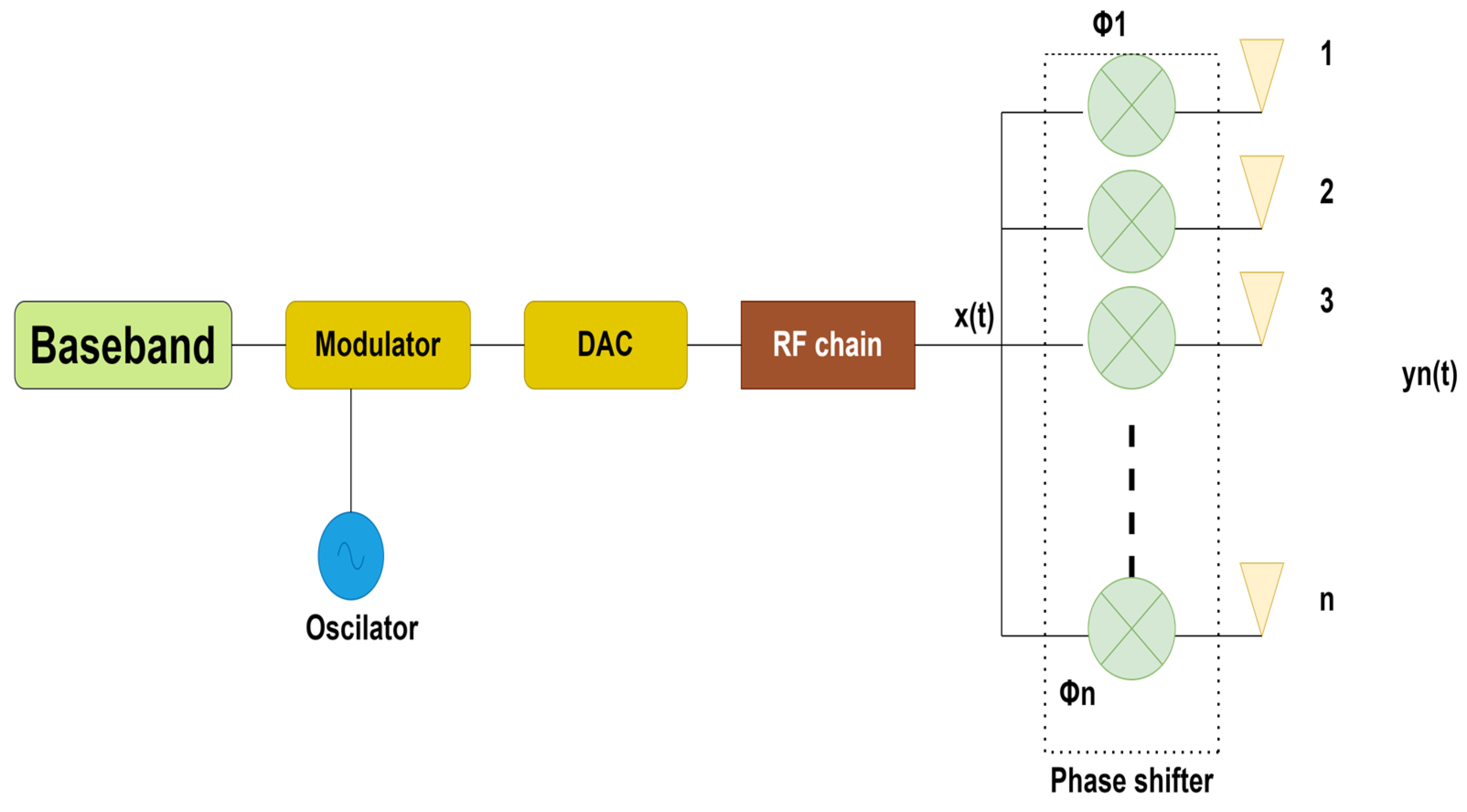
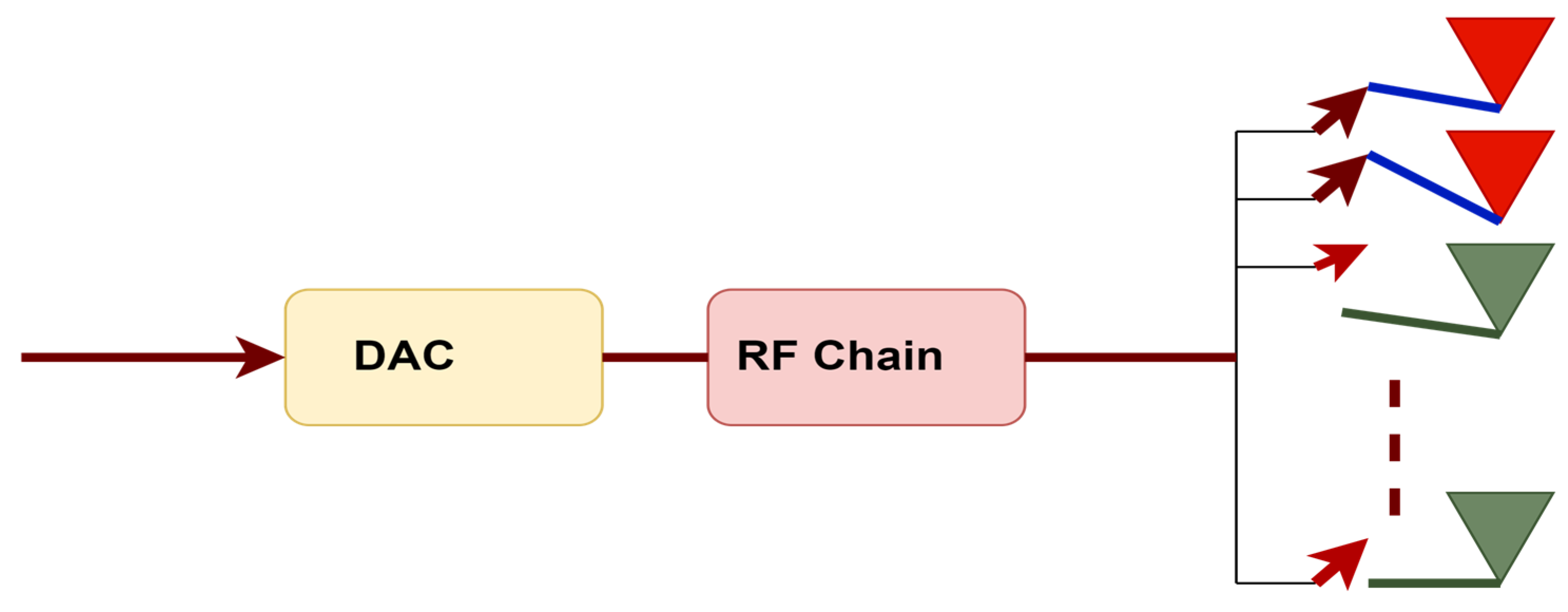
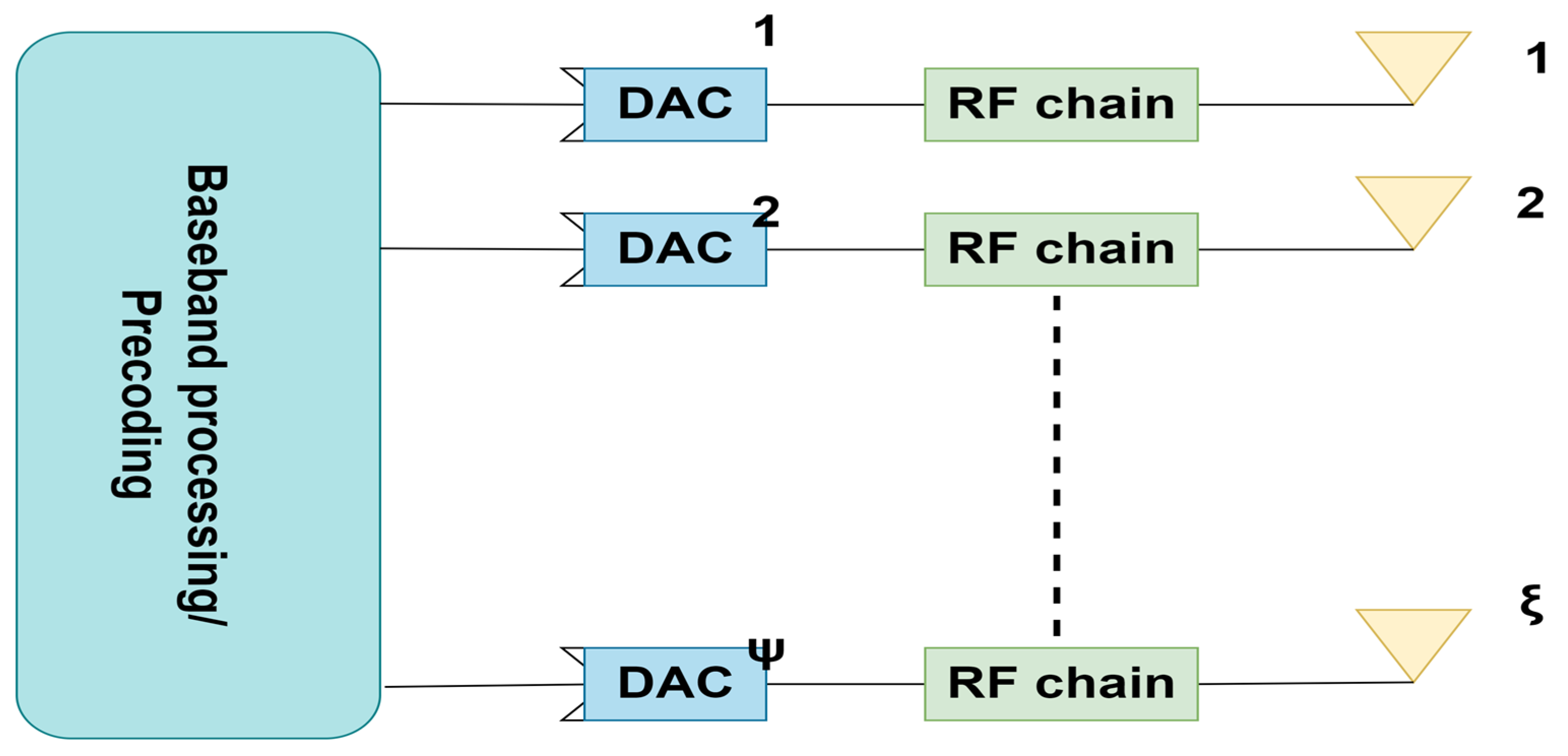
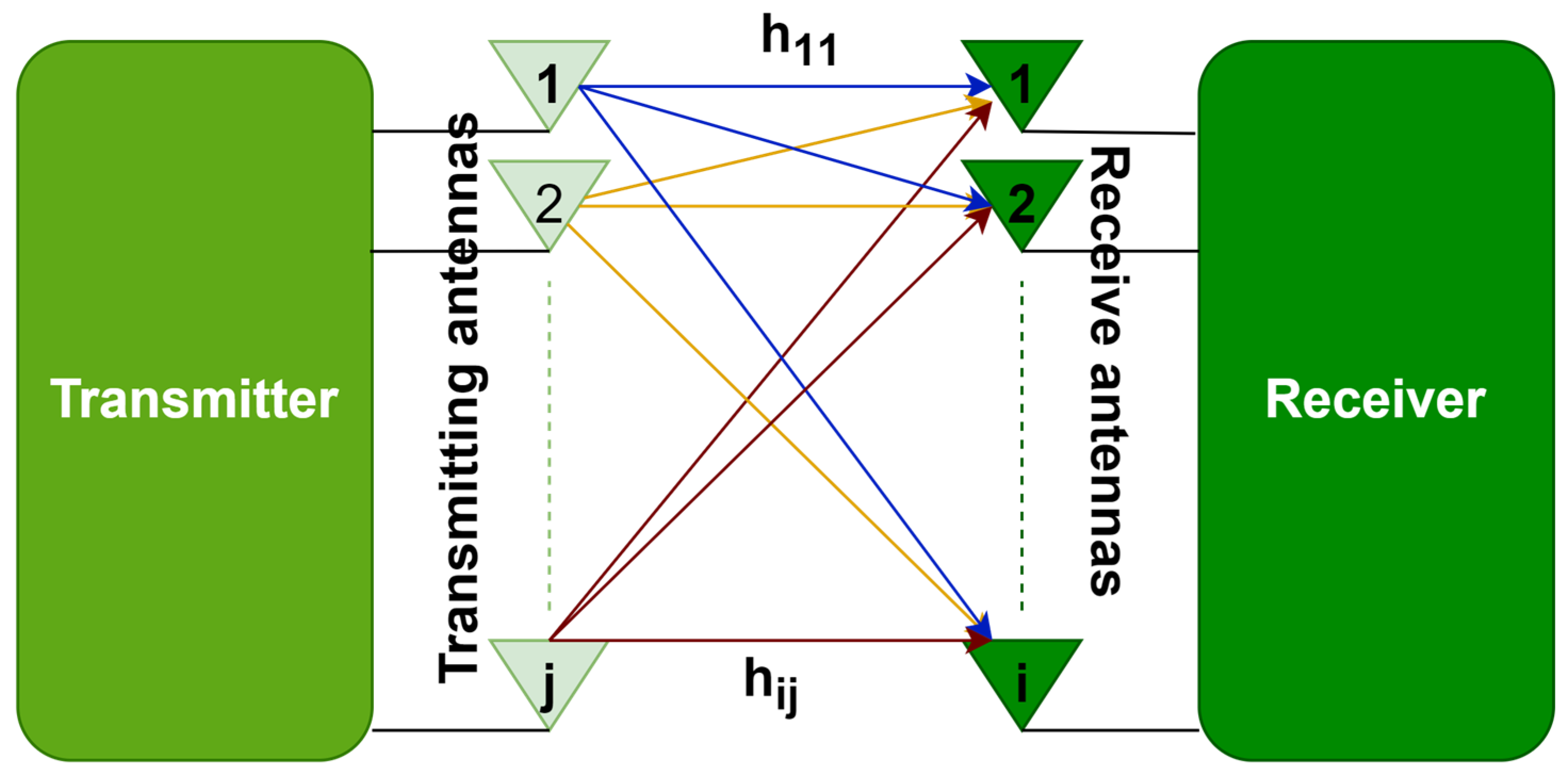
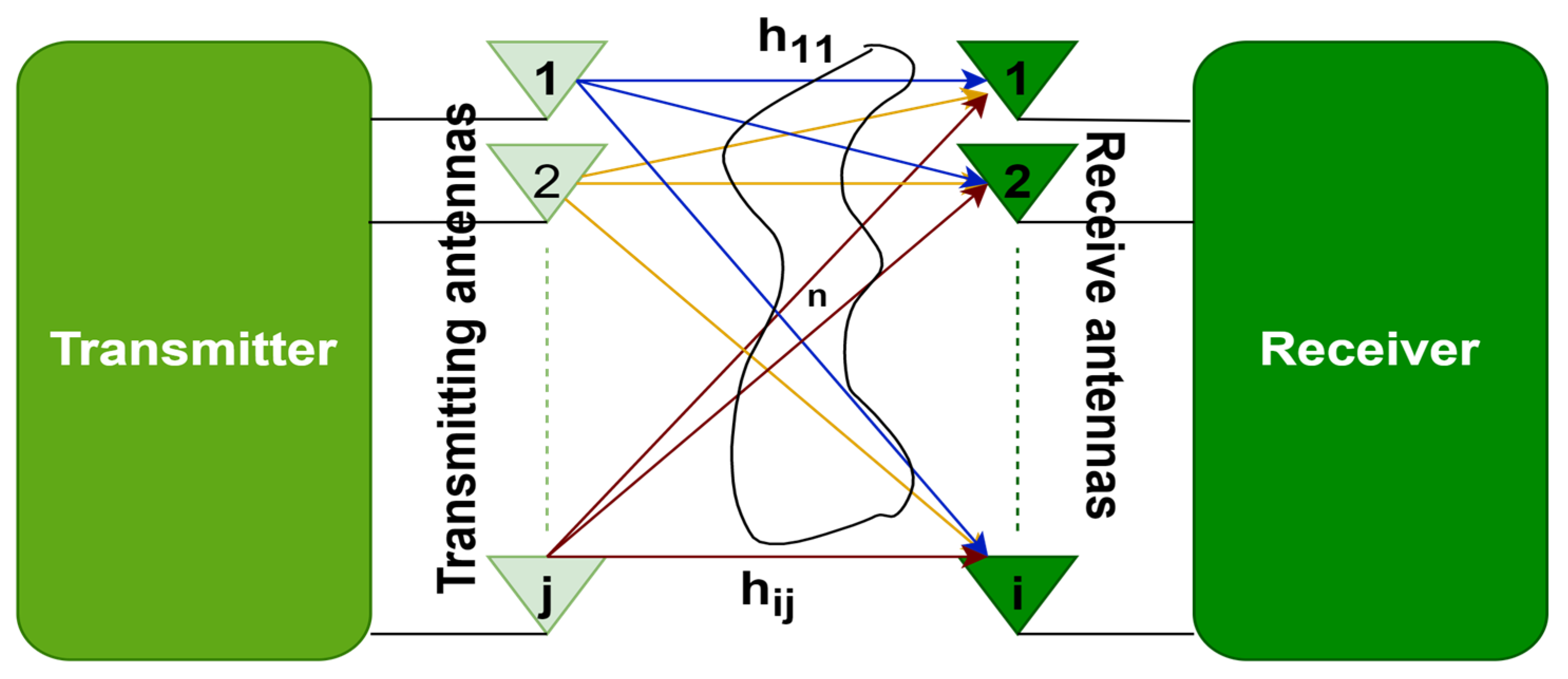

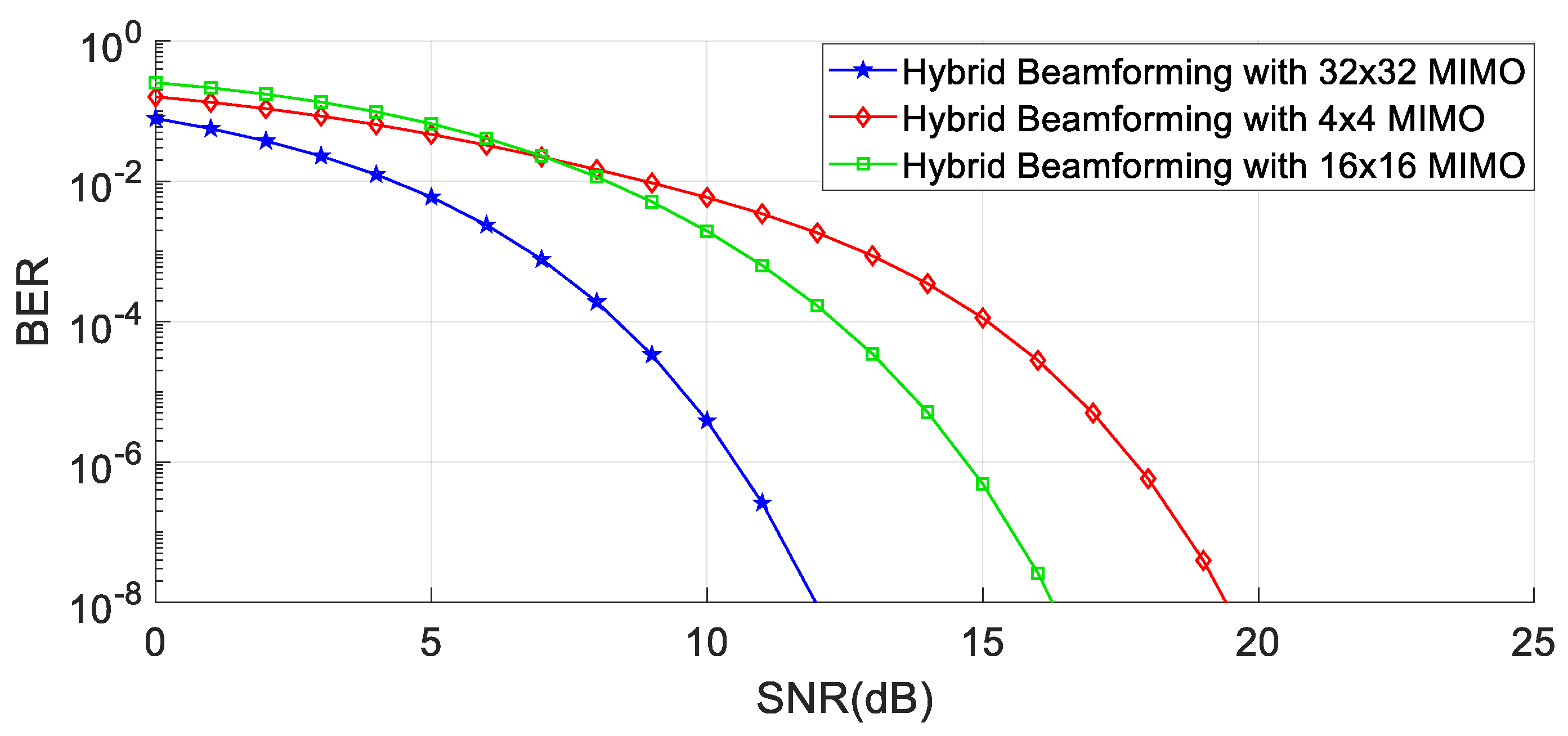
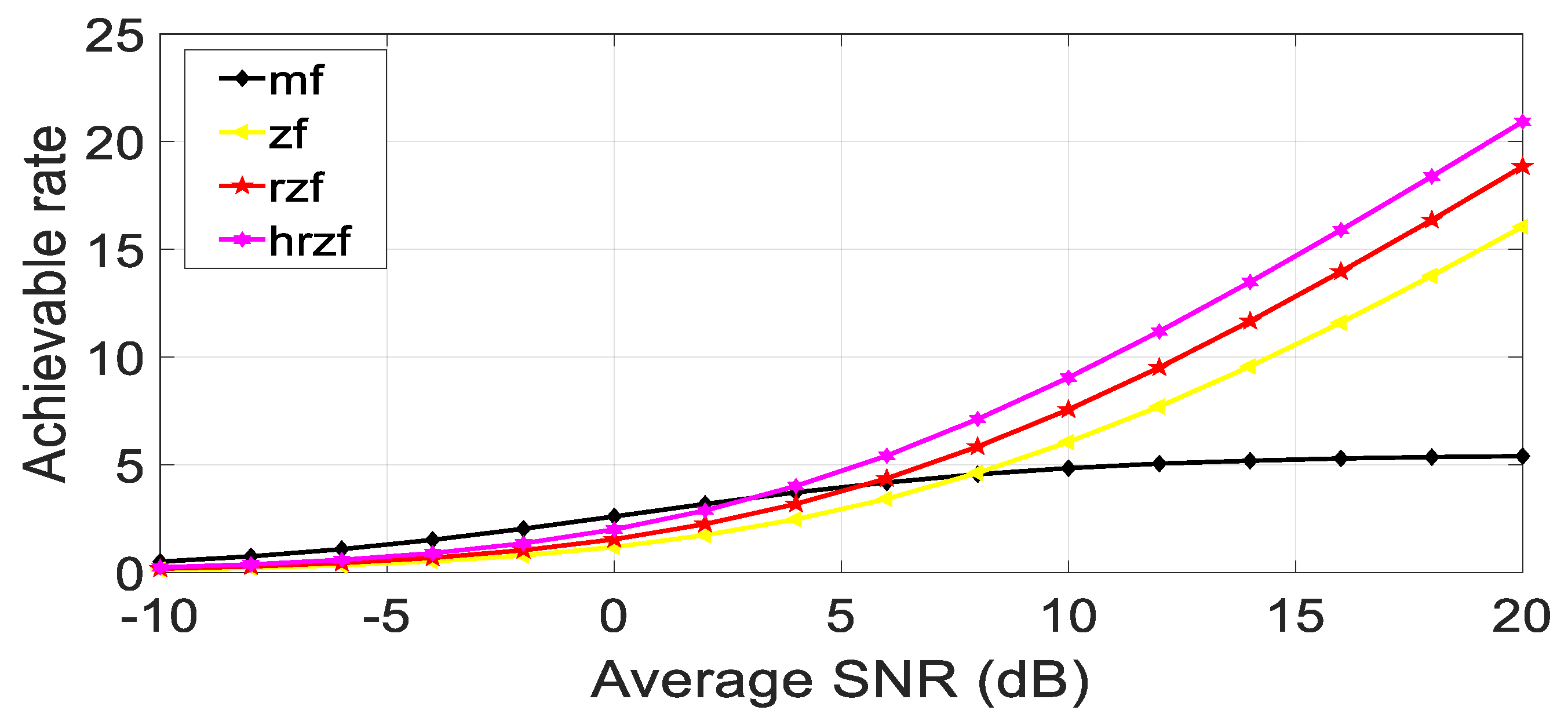
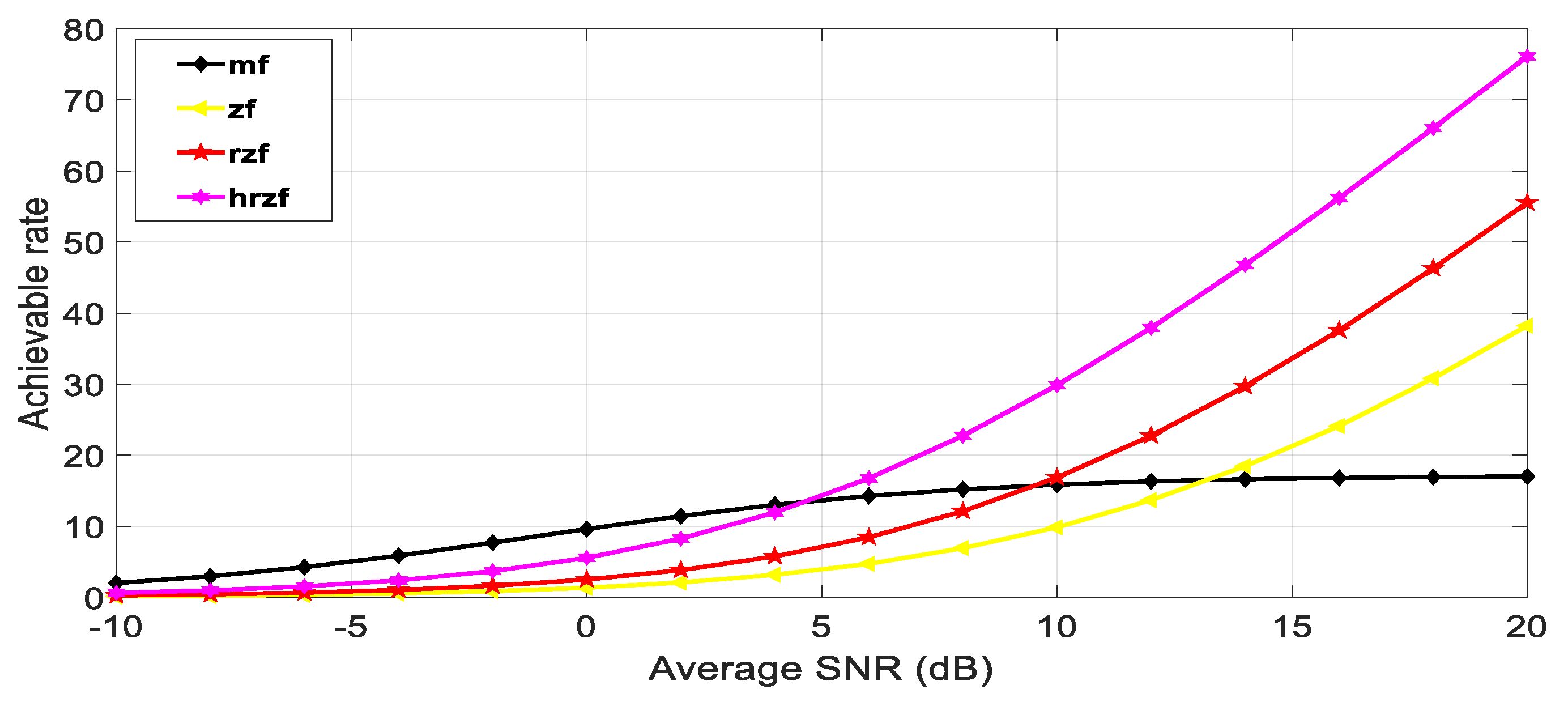
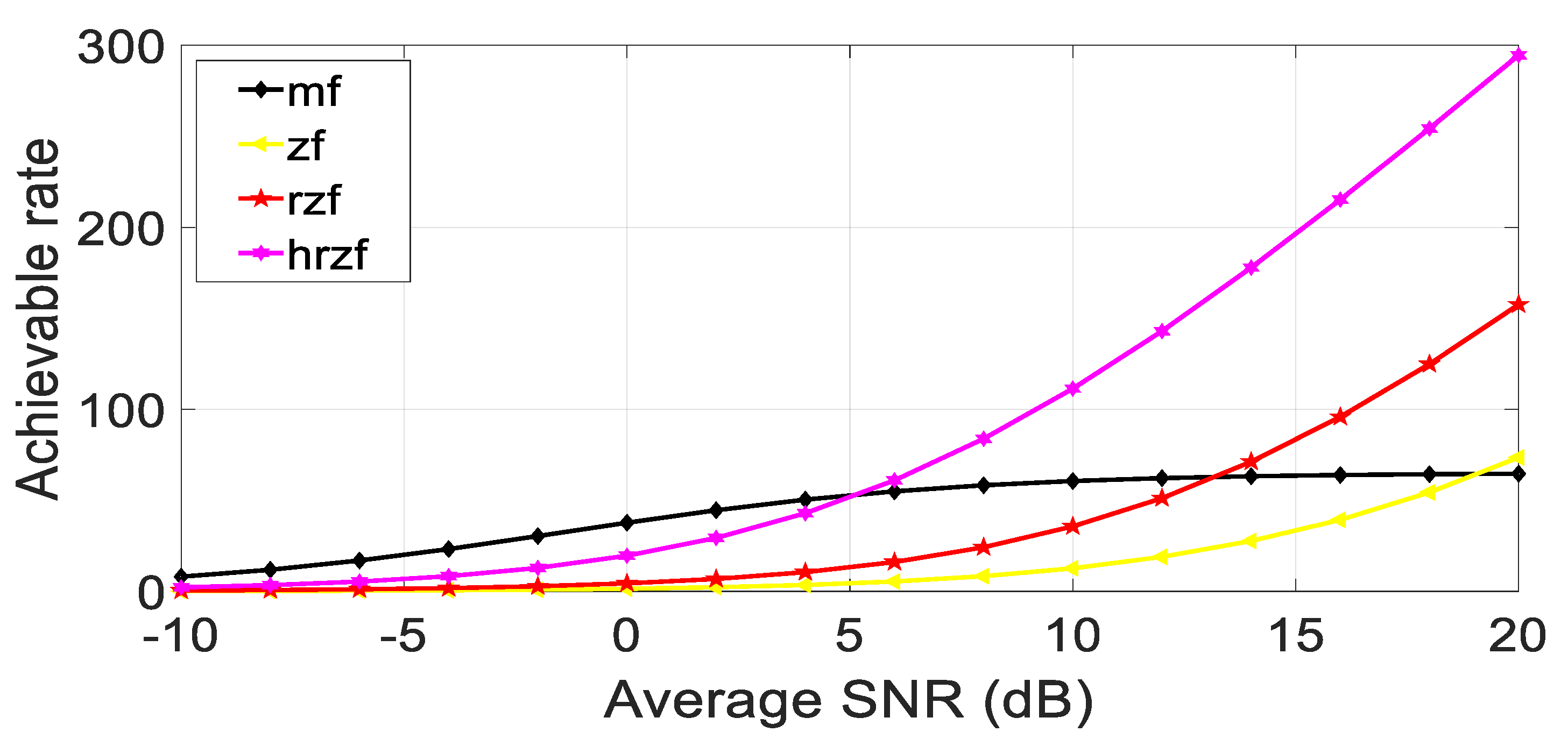
| References | Beamforming Technologies | Methodology | Contribution/Limitation |
|---|---|---|---|
| [4] | Introduction of beamforming with multiple antennas | Constructive interference in desired directions and destructive interference in other directions | Enhanced SNR, energy-efficient and cost-efficient |
| [5] | On–Off analog beamforming | A particular set of antennae is employed for beam formation | Less complex and power-saving than the analog beamforming |
| [6] | Introduction of digital beamforming | Every antenna element possesses an individual RF chain | More flexibility and enhanced SNR/higher complexity and higher power consumption |
| [7] | Hybrid beamforming | A set of antennas are connected to an RF chain | Good flexibility, comparable to digital beamforming |
| [2,8] | Introduction of Analog beamforming | Single radio frequency chain employed for all antenna elements in MIMO | Enhanced SNR/single beam formation at a time |
| [8,9,10] | Fully connected hybrid beamforming | Every RF chain is connected to every antenna element | Flexible, cost-efficient/high signal processing complexity |
| [10,11,12] | Partially connected hybrid beamforming | Set of antennas connected to every RF chain not overlapping each other. | Less expensive and less signal processing as compared to fully connected hybrid beamforming |
| [8] | Group-connected Hybrid beamforming | Antennas and RF chains are divided into η groups; signals emanating from each RF chain group are relayed via its matching antenna group | A flexible grouping strategy, a fully-connected mapping strategy is followed within each group |
| [13] | Hybrid beamforming in MIMO setup | Based on geometric mean decomposition-based beamforming | Large antenna gain, improved BER and SE |
| [4] | 3D beamforming in massive MIMO | Based on user grouping and a group-based feedback system | Allows flexibility in azimuth and elevation |
| Category | Feature/Application/Challenge |
|---|---|
| Key Features | |
| Frequency Range | Sub-THz to THz (100 GHz to 3 THz) |
| Data Rate | Up to 1 Tbps |
| Latency | Less than 1 ms |
| Connection Density | 10 million devices/km2 |
| Energy Efficiency | 10 times more efficient than 5G |
| Mobility | Up to 1000 km/h |
| BF | DoF | Administration | Intricacy | Power Intake | Expenses | IUI | Information Streams |
|---|---|---|---|---|---|---|---|
| Digital | ↑ | ADC/DAC, Mixers | ↑ | ↑ | ↑ | ↓ | >1 |
| Analog | ↓ | Phase shifters | ↓ | ↓ | ↓ | ↑ | 1 |
Disclaimer/Publisher’s Note: The statements, opinions and data contained in all publications are solely those of the individual author(s) and contributor(s) and not of MDPI and/or the editor(s). MDPI and/or the editor(s) disclaim responsibility for any injury to people or property resulting from any ideas, methods, instructions or products referred to in the content. |
© 2023 by the authors. Licensee MDPI, Basel, Switzerland. This article is an open access article distributed under the terms and conditions of the Creative Commons Attribution (CC BY) license (https://creativecommons.org/licenses/by/4.0/).
Share and Cite
Hamid, S.; Chopra, S.R.; Gupta, A.; Tanwar, S.; Florea, B.C.; Taralunga, D.D.; Alfarraj, O.; Shehata, A.M. Hybrid Beamforming in Massive MIMO for Next-Generation Communication Technology. Sensors 2023, 23, 7294. https://doi.org/10.3390/s23167294
Hamid S, Chopra SR, Gupta A, Tanwar S, Florea BC, Taralunga DD, Alfarraj O, Shehata AM. Hybrid Beamforming in Massive MIMO for Next-Generation Communication Technology. Sensors. 2023; 23(16):7294. https://doi.org/10.3390/s23167294
Chicago/Turabian StyleHamid, Shahid, Shakti Raj Chopra, Akhil Gupta, Sudeep Tanwar, Bogdan Cristian Florea, Dragos Daniel Taralunga, Osama Alfarraj, and Ahmed M. Shehata. 2023. "Hybrid Beamforming in Massive MIMO for Next-Generation Communication Technology" Sensors 23, no. 16: 7294. https://doi.org/10.3390/s23167294
APA StyleHamid, S., Chopra, S. R., Gupta, A., Tanwar, S., Florea, B. C., Taralunga, D. D., Alfarraj, O., & Shehata, A. M. (2023). Hybrid Beamforming in Massive MIMO for Next-Generation Communication Technology. Sensors, 23(16), 7294. https://doi.org/10.3390/s23167294











